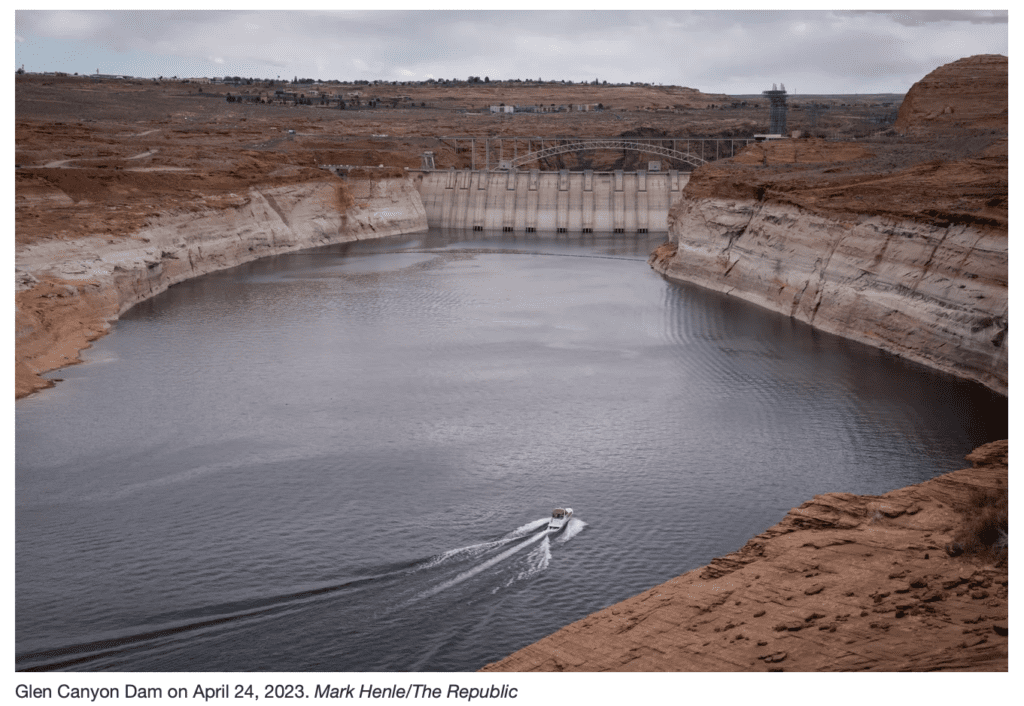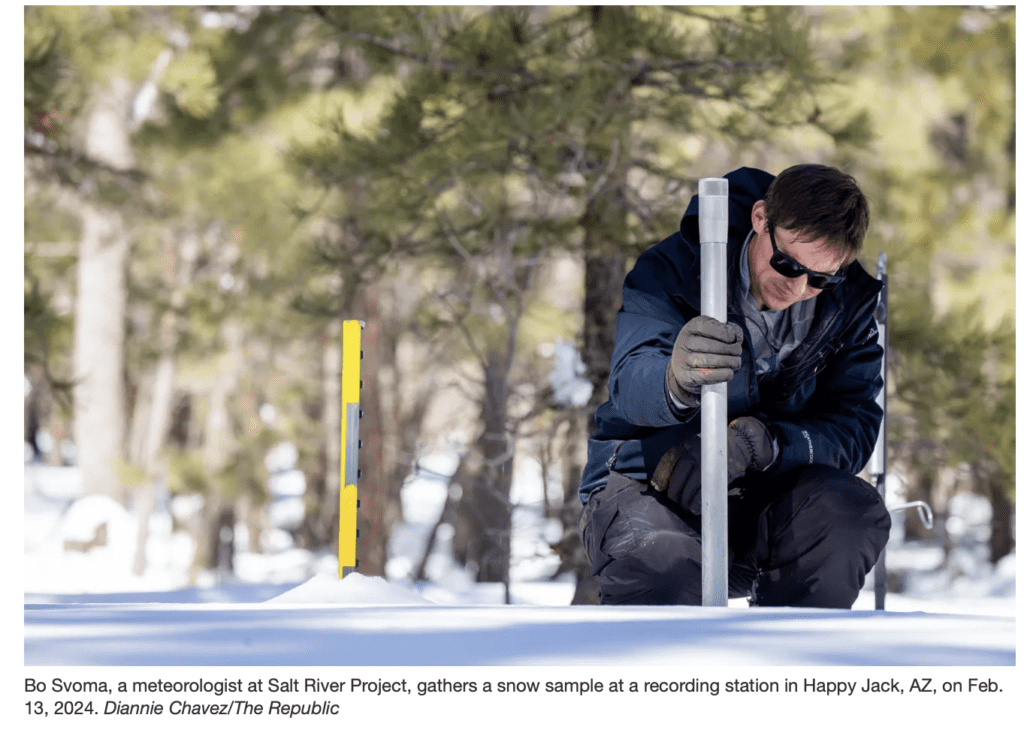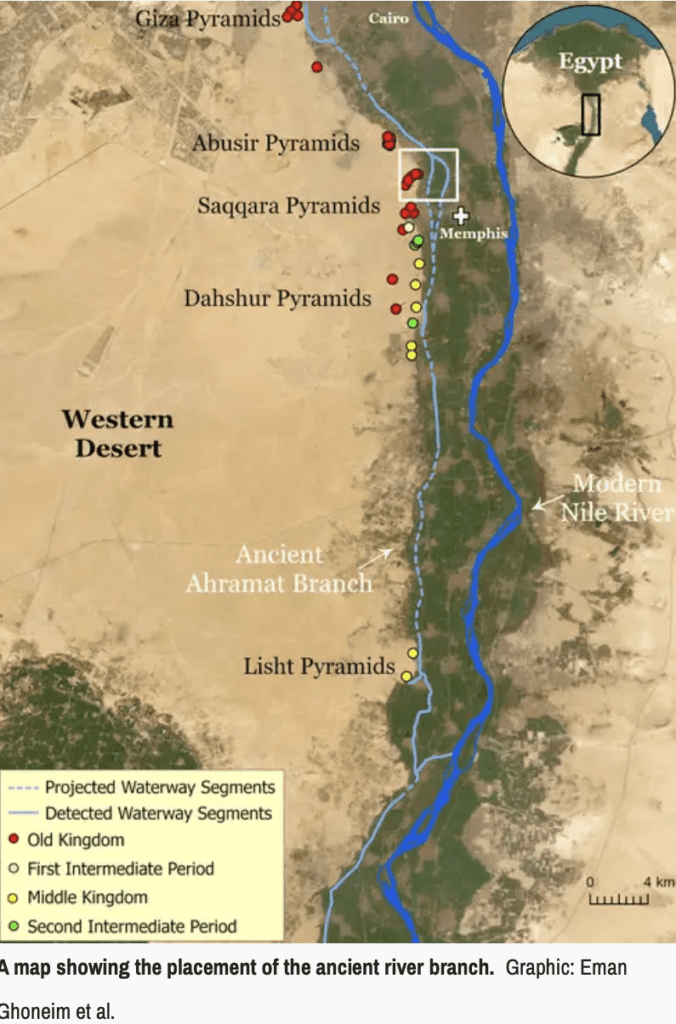Daniel Salzler No. 1255 EnviroInsight.org Four Items May 24, 2024
—————Feel Free To Pass This Along To Others——————
If your watershed is doing something you would like others to know about, or you know
of something others can benefit from, let me know and I will place it in this Information .
If you want to be removed from the distribution list, please let me know.
Please note that all meetings listed are open.
Enhance your viewing by downloading the pdf file to view photos, etc.
The attached is all about improving life in the watershed through knowledge.
If you want to be removed from the distribution list,
please let me know. Please note that all meetings listed are open.
Check our website at EnviroInsight.org
1. A Once-Promising Colorado River Forecast Is Downgraded After Mediocre April Snowfall. A dry April around the Colorado River Basin melted hopes for a second-straight banner year of big runoff to swell Lake Powell’s reservoir storage, government hydrologists say. The result is a likely holding pattern for drought responses over the next two years, according to the U.S. Bureau of Reclamation. Water levels in Lake Powell and Lake Mead are unlikely to rise as they did after the strong snowpack that accumulated over the 2022-2023 winter, but are also unlikely to tip the Southwest into a new tier of water austerity measures.
The mountain snow season started out dry, came on strong in the middle, and came to an abrupt standstill in April.
“We’ve had kind of a yo-yo in regards to precipitation and snowpack,” Reclamation hydrologist Heather Patno told members of a Glen Canyon Dam Adaptive Management Program working group on Wednesday.
More than 40 million people rely on the Colorado River for water in cities and on farms in seven states, including Arizona. Drought restrictions have not affected water users in homes and businesses, but have curtailed the flow to some farmers, especially in Pinal County.
With the exception of the Colorado headwaters and Arizona’s Verde River, most areas of the seven-state watershed experienced below-average April snow and rain, according to the Colorado Basin River Forecast Center. What had generally been above-average snowpack water content throughout the region in late-winter turned toward normal or below average as meltwater started flowing toward Lake Powell.

“April precipitation as a percent of average was quite poor across most of the region,” National Oceanic and Atmospheric Administration hydrologist Cody Moser said during the forecast center’s monthly briefing. Much of the watershed experiences just half to 70% of normal April precipitation.
Snowpack numbers drop during a drier April
For the water year that began in October, total precipitation in areas flowing toward Lake Powell stood at about 97% of the 30-year average this month, he said.
A relatively dry month above the big reservoir had reduced an April 1 snow-water equivalent reading that was 113% of the median to just 89% by May 1. Snow-water equivalent describes the amount of water that would result from melting snow.

Reclamation, which manages Powell’s releases past Glen Canyon Dam, now predicts the water flowing toward the reservoir through the end of runoff season in July will come in at 81% of average, totaling 7.9 million acre-feet. With the agency set to release 7.48 million acre-feet toward Lake Mead this year, Powell’s storage capacity is not expected to change much.
It is currently 34% full and most likely will end the year at 37%, according to the agency’s calculations.
This middling outlook stands in contrast to a year ago, when big snows led Reclamation to predict flows at 172% of average, which gave both Powell and Mead reprieves from disaster built up over two decades of drought.
Negotiating long-term guidelines
While this year’s meltwater is unlikely to buoy the reservoirs much further, a year that doesn’t further deplete them can be viewed as a success. If the current predictions hold up, the agency projects that emergency water conservation measures adopted this year in the Southwest will keep supplies stable for at least a couple of years. Officials announced in March that the negotiated plan would keep 3 million acre-feet of water in storage through 2026. The agency signed the plan this month.
To ensure stability beyond that, the states, tribes and federal officials are negotiating longer-term guidelines that will mandate further water savings unless a wet streak refills the reservoirs to capacity, a level not seen yet in this century. The U.S. Interior Department is set to propose its chosen guidelines by year’s end.
Within Arizona, the Salt River Project’s outlook for water supplies is strong for the second year in a row. The metro Phoenix supplier said its Salt and Verde watershed reservoirs entered May at 93% of capacity. Source: Brandon Loomis,Arizona Republic
2. An Idea For Arizona Waterways? New Brew Aims To Help Keep Milwaukee Waterways Clean. Duckweed Lager will be available at Boone and Crockett starting on Memorial Day week. A new beer, called Duckweed Lager, is set to launch in Milwaukee with the aim of contributing to the cleanliness of the city’s waterways through the proceeds from its sales.
“We can’t have good beer without clean water. And Central Waters is kind of been on the forefront of green and sustainable brewing practices since we started,” said Joey Abbot, the sales manager at Central Waters Brewing.
Under their Milwaukee taproom, the new beer is almost ready.
“We’ve got beer. We’ve got Boone and Crockett with bringing people together and bringing communities together. And then Milwaukee Riverkeeper. We’re really focused on water quality and having clean water for beer,” Jennifer Bolger Breceda said.
Breceda runs Milwaukee Riverkeeper, an environmental non-profit that leads cleanups, fishing clinics and community education.
Proceeds from the new Duckweed Lager will help their programs.
“It’s such a great opportunity to support a nonprofit that helps support all of the waterways of Wisconsin. So every portion of each barrel that we go through will be donated to the Milwaukee Riverkeeper,” said Emily Dell Revord, co-owner of Boone and Crockett.
The beer will be sold exclusively at Boone and Crockett, a popular gathering spot on the Kinnickinnic River in the Harbor District.
“You’re going to have a nice, clean finish with it. You’ll be able to drink it all day long. We want everybody to be able to have a pint and enjoy it,” Abbot said.
The creators of Duckweed Lager hope that the beer will have a lasting impact on keeping Milwaukee’s waterways clean.
The Duckweed Lager will be available at Boone and Crockett starting Memorial Day weekend.
Source: WISN Milwaukee
3. Were Egypt’s Pyramids Built On Branch Of The Nile River That Dried Up? Dozens of Egypt’s most famous pyramids may have been built thanks to this long-lost transit corridor.

Thirty-one different Egyptian pyramids appear to have been built along a branch of the Nile River that dried up millennia ago, according to new research published in “Communications Earth & Environment”.
The group of pyramids — which include the famous pyramids of Giza and others like the Bent Pyramid and the Step Pyramid of Djoser — now exist on a narrow strip of desert west of the Nile. They were build over a millennium, beginning about 4,700 years ago. According to the authors of the recent study, there was once a 40-mile-long (64-kilometer) branch of the Nile that extended through the now inhospitable landscape, explaining the rather odd placement of the pyramids so far from the Nile, the longest river in the world and the lifeblood of Ancient Egyptian civilization.
“Revealing this extinct Nile branch can provide a more refined idea of where ancient settlements were possibly located in relation to it and prevent them from being lost to rapid urbanization,” the team wrote. “This could improve the protection measures of Egyptian cultural heritage.”

The team identified the branch — long since filled in by silt — using satellite imagery, geophysical surveys, and sediment cores sampled from the Western Desert Plateau. They propose dubbing the ancient branch Ahramat, Arabic for “pyramids.”
The team also found that many of the pyramids they studied along the Western Desert Plateau had causeways which terminated where the Ahramat Branch ran. Thus, the team proposes that the river branch was likely used to transport construction materials for the pyramids, a set of projects so gargantuan that the History Channel “Aliens” meme always needs to be kept close at hand.
Inlets that fed the Ahramat Branch are also filled in by sand today, making them invisible to optical satellite imagery. But radar and topographic data of the sites revealed the inlets’ riverbeds as well as the causeways that led to the pyramids of Pepi II and Merenre.
The causeways of several other pyramids (Khafre, Menakure, and Kentkaus) led to another arm of the river the team dubbed the Giza Inlet, indicating that the river branch was still running in the Old Kingdom’s fourth dynasty. Archaeologist Eman Ghoneim from the University of North Carolina Wilmington led the research.
However, the team concluded that the writing was on the wall for the Ahramat Branch beginning around 4,200 years ago, when a major drought may have increased the amount of wind-blown sand that slowly filled in the branch, eventually obscuring it even to satellite imagery. But thanks to radar imagery and sediment coring, an ancient resource of the Egyptians has come to light. Source: ByIsaac Schultz / Gizmodo
4. Memorial Day Is An American Holiday, Observed On The Last Monday Of May, honoring the men and women who died while serving in the U.S. military. Memorial Day 2024 will occur on Monday, May 27.
Originally known as Decoration Day, it originated in the years following the Civil War and became an official federal holiday in 1971. Many Americans observe Memorial Day by visiting cemeteries or memorials, holding family gatherings and participating in parades. Unofficially, it marks the beginning of the summer season.

The Civil War, which ended in the spring of 1865, claimed more lives than any conflict in U.S. history and required the establishment of the country’s first national cemeteries.
By the late 1860s, Americans in various towns and cities had begun holding springtime tributes to these countless fallen soldiers, decorating their graves with flowers and reciting prayers.
It is unclear where exactly this tradition originated; numerous different communities may have independently initiated the memorial gatherings. And some records show that one of the earliest Memorial Day commemorations was organized by a group of formerly enslaved people in Charleston, South Carolina less than a month after the Confederacy surrendered in 1865. Nevertheless, in 1966 the federal government declared Waterloo, New York, the official birthplace of Memorial Day.
Waterloo—which first celebrated the day on May 5, 1866—was chosen because it hosted an annual, community-wide event, during which businesses closed and residents decorated the graves of soldiers with flowers and flags.
On May 5, 1868, General John A. Logan, leader of an organization for Northern Civil War veterans, called for a nationwide day of remembrance later that month. “The 30th of May, 1868, is designated for the purpose of strewing with flowers, or otherwise decorating the graves of comrades who died in defense of their country during the late rebellion, and whose bodies now lie in almost every city, village and hamlet churchyard in the land,” he proclaimed.
The date of Decoration Day, as he called it, was chosen because it wasn’t the anniversary of any particular battle.
On the first Decoration Day, General James Garfield made a speech at Arlington National Cemetery, and 5,000 participants decorated the graves of the 20,000 Civil War soldiers buried there.
Many Northern states held similar commemorative events and reprised the tradition in subsequent years; by 1890 each one had made Decoration Day an official state holiday. Southern states, on the other hand, continued to honor the dead on separate days until after World War I.
Memorial Day, as Decoration Day gradually came to be known, originally honored only those lost while fighting in the Civil War. But during World War I the United States found itself embroiled in another major conflict, and the holiday evolved to commemorate American military personnel who died in all wars, including World War II, The Vietnam War, The Korean War and the wars in Iraq and Afghanistan.
For decades, Memorial Day continued to be observed on May 30, the date General Logan had selected for the first Decoration Day. But in 1968, Congress passed the Uniform Monday Holiday Act, which established Memorial Day as the last Monday in May in order to create a three-day weekend for federal employees. The change went into effect in 1971. The same law also declared Memorial Day a federal holiday. Source: https://www.history.com/topics/holidays/memorial-day-history
Memorial DayQuestions.
1.Question: What city is known as the birthplace of Memorial Day?
2. Question: Memorial Day was originally known as what?
3 Question: Memorial Day was first recognized on what date?
4. Question: When was Memorial Day named as such by the federal government?
5. Question: What act moved Memorial Day from May 30 to the last Monday in May each year?
6. Question: When did Memorial Day move from May 30 to the last Monday in May?
7. Question: Arlington National Cemetery used to be a plantation belonging to whom?
8. Question: Who spoke at the first Memorial Day ceremony at Arlington National Cemetery?
Answers:
1 Answer: Waterloo, New York
2. Answer: Decoration Day
3. Answer: May 30, 1868
4. Answer: 1971
5. Answer: The Uniform Monday Holiday Act
6. Answer: 1971
7. Answer: Robert E. Lee (Bonus points if you said it originally belonged to George Washington‘s step-grandson, George Washington Parke Custis).
8. Answer: Ohio CongressmanJames A. Garfield
Copyright: 2024 EnviroInsight.org
